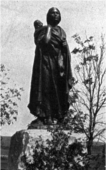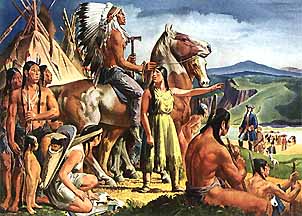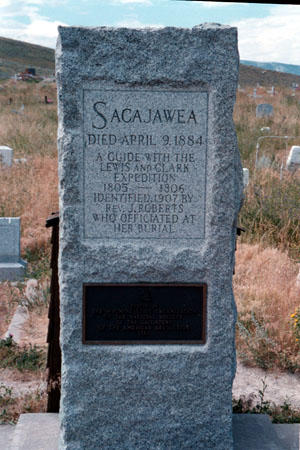|
|
Sacajawea
c. 1784-1884?, Native North American woman guide on the Lewis and Clark expedition and the only woman to accompany the party. Little is known of her life, either, other than her brief brush with fame as a guide to the Lewis and Clark expedition, exploring the American West in 1804-1806. She is generally called the Bird Woman in English, although this translation has been challenged, and there has been much dispute about the form of her Native American name.
Sacagawea was born to the Shoshone Indians, about 1788. In 1800, at the age of 12, she was kidnapped by Hidatsa (or Minitari) Indians and taken from what is now Idaho to what is now North Dakota.
Later, she was sold as a slave to the French Canadian trader Toussaint Charbonneau, along with another Shoshone woman. He took them both as wives, and in 1805, Sacagawea's and Charbonneau's son, Jean-Baptiste Charbonneau, was born.
The Lewis and Clark expedition recruited Charbonneau and Sacagawea to accompany them westward, expecting to make use of Sacagawea's ability to speak to the Shoshone. The expedition expected that they would need to trade with the Shoshone for horses. Sacagawea spoke no English, but she could translate to Hidatsa to Charbonneau, who could translate to French for Francois Labiche, a member of the expedition, who could translate into English for Lewis and Clark.
President Thomas Jefferson in 1803 asked for funding from Congress for Meriwether Lewis and William Clark to explore the western territories between the Mississippi River and the Pacific Ocean. Clark, more than Lewis, respected the Indians as fully human, and treated them as sources of information rather than as bothersome savages, as other explorers too often did.
She was a member of the Shoshone, had been captured and sold to a Mandan, and finally was traded to Toussaint Charbonneau, one of whose wives she became. He was interpreter for the expedition. She proved invaluable as a guide and interpreter when Lewis and Clark reached the upper Missouri River and the mountains from which she had come. On the return journey she and Charbonneau left (1806) the expedition at the Mandan villages. While some historians date Sacajawea's death around 1812, there are others who claim that she was discovered by a missionary in 1875 and that she actually died in Wyoming in 1884. Sacajawea or Sacagawea?
While most of the news stories and web biographies of this now-more-famous woman spell her name Sacajawea, the original spelling during the Lewis and Clark expedition was with a "g" not a "j": Sacagawea. The sound of the letter is a hard "g" so it's hard to understand how the change came to be.
PBS in a website designed to accompany the Ken Burns film on Lewis and Clark, documents that her name is derived from the Hidatsa words "sacaga" (for bird) and "wea" (for woman). The explorers spelled the name Sacagawea all seventeen times they recorded the name during the expedition.
Others spell the name Sakakawea and with several other variations as well. Because the name is a transliteration of an unwritten name, these differences of interpretation are to be expected. Traveling with Lewis and Clark

Accompanied by her infant son, Sacagawea set out with the expedition for the west. Her memory of Shoshone trails proved valuable, according to some sources; according to others, she did not serve as a guide to the trails so much as to useful foods and medicines along the way. Her presence as an Indian woman with a baby helped to convince Indians that this party of whites was friendly. And her translation skills, however indirect from Shoshone to English, were also invaluable at several key points.
The only woman on the trip, she also cooked, foraged for food, and sewed, mended and cleaned the clothes of the men. In one key incident recorded in Clark's journals, she saved records and instruments from being lost overboard during a storm.
Sacagawea was treated as a valuable member of the party, even given a full vote in deciding where to spend the winter of 1805-6, though at the end of the expedition, it was her husband and not she who was paid for their work.
When the expedition reached Shoshone country, they encountered a band of Shoshone. Surprisingly, the leader of the band was Sacagawea's brother.
Twentieth century legends of Sacagawea have stressed -- most scholars would say falsely -- her role as a guide in the Lewis and Clark expedition. While she was able topoint out a few landmarks, and her presence was enormously helpful in many ways, it's clear that she did not herself lead the explorers in their cross-continental journey. After the Expedition
On returning to the home of Sacagawea and Charbonneau, the expedition paid Charbonneau with money and land for the work of Sacagawea and himself.
A few years later, Clark apparently arranged for Sacagawea and Charbonneau to settle in St. Louis. Sacagawea gave birth to a daughter, and shortly after died of an unknown illness. Clark legally adopted her two children, and educated Jean Baptiste (some sources call him Pompey) in St. Louis and Europe. He became a linguist and later returned to the west as a mountain man. It is unknown what happened to the daughter, Lisette.
The PBS' website on Lewis and Clark details the theory of another woman who lived to 100, dying in 1884 in Wyoming, who has long been identified mistakenly as Sacagawea.
Evidence for the early death of Sacagawea include Clark's notation of her as dead in a list of those who were on the journey.

Sacajawea, known as the Shoshone Bird Woman, directs the Lewis and Clark expedition over the perilous passes to safety, succeeding in persuading the rest of her tribe to overcome suspicion and hostility.
Native Woman
The Sacagawea Golden Dollar
The first new coin of the millennium
Source: The U.S. Mint

The Sacagawea Golden Dollar coins debuted in January 2000. The new dollar coin replaced the Susan B. Anthony (SBA) dollar coin, which had circulated since 1979. Because demand had increased for a dollar coin in commerce, the government's supply of SBA dollars was nearly exhausted, creating a need for a new dollar coin that would be easily distinguishable from other change.
The United States Dollar Coin Act of 1997 required the Treasury Department to place into circulation a new dollar coin similar in size to the Susan B. Anthony dollar coin, golden in color with a distinctive edge. The law required the Treasury Secretary, in consultation with Congress, to select the designs for both sides of the new coin, although the design on the tails (reverse) side is required under the statute to depict an eagle.
Is It Really Gold?
Both the Golden Dollar and the SBA are clad coins, sharing a three-layer composite construction, with a pure copper core sandwiched between and metallurgically bonded to the outer layers of alloy material. The overall composition of the new Golden Dollar is 88.5% copper, 6.0% zinc, 3.5 % manganese, and 2.0% nickel. The coin's composite construction provides security features that allow machines to distinguish it from slugs, tokens, and foreign coins.
Who Was Sacagawea?
Sacagawea was the Shoshone Indian who assisted the historic Lewis and Clark expedition. Between 1804-1806, while still a teenager, she guided the adventurers from the Northern Great Plains to the Pacific Ocean and back. Her husband, Toussaint Charbonneau, and their son who was born during the trip, Jean Baptiste, also accompanied the group.
Without Sacagawea's navigational, diplomatic, and translating skills, the famous Lewis and Clark expedition would have perished. For one, she helped Lewis and Clark obtain the horses they needed to continue their journey.
Additional Resources
Pomp: The True Story of the Baby on the Sacagawea Dollar - Learn about Pomp's later life as an adventurer in the American West.
Sacagawea - Guide to Lewis and Clark - Collection of links to sites about Sacagawea from About.com.
Sacagawea, Bird Woman - Short history of Sacagawea, the Shoshone Indian woman who lead the Lewis and Clark expedition to the Pacific Ocean as a guide and interpreter.
Sacagawea: Guide to the West? - The history of Sacagawea, guide for the Lewis and Clark expedition. From about.com.
Woman Spirit - Short history of Sacajawea by Julia White.
PBS Online: Lewis and Clark - Companion site to the Ken Burns film, 'Lewis and Clark: The Journey of the Corps of Discovery.' Information on the explorers, expedition journals, trip timeline and maps, interviews with historical experts, an overview of Native American tribes, and classroom lessons. AITLC Guide to Lewis and Clark - A teacher's guide to resources available online. Along the Trail with Lewis and Clark - Provides journals and maps from the expedition. Discovering Lewis and Clark - Interactive workshop providing an overview of the journey of Lewis and Clark, including journal excerpts. Following the Voyage of Discovery - A few historical FAQs, with an expedition map. The History of the Lewis and Clark Expedition - Expedition overview by the Lewis and Clark Trail Heritage Foundation. Jefferson's Letter - Read the contents of Jefferson's letter of commission to Meriwether Lewis exactly as it was written. The Journey to Fort Clatsop - Detailed narrative of the Lewis and Clark Expedition to the Pacific. Includes President Jefferson's letter of instructions to Captain Lewis. Lewis and Clark - National Geographic's expedition gallery, with references. Lewis and Clark - Ohio River Chapter - The mission of the Lewis and Clark Trail Heritage Foundation is to honor the historic legacy of Lewis and Clark through research, education, preservation, promotion, and coordination. Lewis and Clark Education Center - Engages educators and students in a dynamic understanding of The Lewis and Clark Expedition (1803-1806). Lewis and Clark History Day - Expedition paintings and summary, with an annotated subject bibliography. Lewis and Clark Internet Archive - A links directory of several hundred sites related to the Lewis and Clark expedition. Lewis and Clark Trail - Historical account of the Corps of Discovery along the Lewis and Clark Trail. Includes an events calendar, trail properties, and trail treasures. Meriwether Lewis: A Portrait of an American Explorer and Hero - Biography takes a look at his early years, western exploration, years as governor of the Louisiana Territory, and his mysterious death. Sgt. Charles Floyd: A Short Biography - A brief biographical essay on Sergeant Charles Floyd, the only member of the Lewis and Clark expedition who died during their journey.

Return to
NativeAmericans.com
|
|
|
|
|
 Native American Nations
Native American Nations
